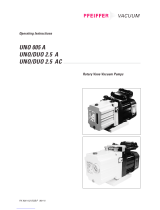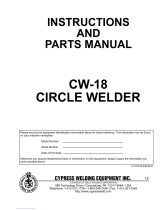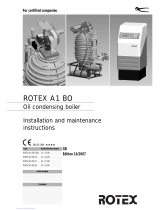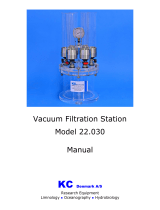
Get technical data,
instruction manuals,
service kits
COBRA
Dry Screw Vacuum Pumps
NC 0600 C, NC 0630 C
Water-Cooled Version (WCV)
Instruction Manual
0870567092 | A0007_en-US | Original instructions 4/14/2023

Table of Contents
2 | 48 Instruction Manual COBRA NC 0600-0630 C WCV_EN_en
Table of Contents
1 Safety ..................................................................................................................................................................... 4
2 Product Description ............................................................................................................................................. 5
2.1 Operating Principle............................................................................................................................................. 6
2.2 Intended Use ....................................................................................................................................................... 6
2.3 Start Controls....................................................................................................................................................... 7
2.4 Standard Features............................................................................................................................................... 7
2.4.1 Water Cooling ....................................................................................................................................... 7
2.4.2 Temperature Switch............................................................................................................................. 7
2.4.3 Thermometer........................................................................................................................................ 7
2.4.4 Sealing Systems .................................................................................................................................... 7
2.5 Optional Accessories........................................................................................................................................... 7
2.5.1 Inlet Filter .............................................................................................................................................. 7
2.5.2 Gas Ballast Valve................................................................................................................................... 7
2.5.3 Silencer .................................................................................................................................................. 7
2.5.4 Barrier Gas System............................................................................................................................... 7
2.5.5 Mechanical Seals .................................................................................................................................. 8
2.5.6 Nitrogen Panel...................................................................................................................................... 8
2.5.7 Liquid Flushing Device ......................................................................................................................... 8
3 Transport............................................................................................................................................................... 9
4 Storage................................................................................................................................................................... 10
5 Installation............................................................................................................................................................ 11
5.1 Installation Conditions ....................................................................................................................................... 11
5.2 Connecting Lines / Pipes .................................................................................................................................... 11
5.2.1 Suction Connection .............................................................................................................................. 12
5.2.2 Discharge Connection.......................................................................................................................... 12
5.2.3 Cooling Water Connection .................................................................................................................. 13
5.2.4 Barrier Gas System Connection (Optional)........................................................................................ 14
5.2.5 Dilution Gas System Connection (Optional)...................................................................................... 16
5.2.6 Purge Gas System Connection (Optional) ......................................................................................... 17
5.3 Filling Oil............................................................................................................................................................... 18
5.4 Filling Cooling Liquid .......................................................................................................................................... 19
5.5 Liquid Flushing Device Installation (Optional)................................................................................................. 20
5.6 Fitting the Coupling ............................................................................................................................................ 21
6 Electrical Connection ........................................................................................................................................... 22
6.1 Machine delivered without Variable Speed Drive ........................................................................................... 22
6.2 Machine delivered with a Variable Speed Drive (Option)............................................................................... 24
6.3 Wiring Diagram Three-Phase Motor (Pump Drive)......................................................................................... 25
6.4 Wiring Diagram Solenoid Valve (Optional) ...................................................................................................... 26
6.5 Electrical Connection of the Monitoring Devices ............................................................................................ 26
6.5.1 Wiring Diagram Temperature Switch ................................................................................................ 27
6.5.2 Wiring Diagram Flow Switch (Optional)............................................................................................. 27
6.5.3 Wiring Diagram Level Switch (Optional)............................................................................................ 27
7 Commissioning ..................................................................................................................................................... 28
7.1 Conveying Condensable Vapors........................................................................................................................ 29
7.2 Liquid Flushing Procedure ................................................................................................................................. 30
7.3 Gas Purging Procedure ...................................................................................................................................... 30
8 Maintenance ......................................................................................................................................................... 31
8.1 Maintenance Schedule ....................................................................................................................................... 32

Table of Contents
Instruction Manual COBRA NC 0600-0630 C WCV_EN_en 3 | 48
8.2 Oil Level Inspection............................................................................................................................................. 33
8.3 Cooling Liquid Level Inspection ........................................................................................................................ 33
8.4 Replacing the Gas Ballast Filter (Optional)....................................................................................................... 34
8.5 Oil Change............................................................................................................................................................ 34
8.6 Cooling Liquid Change ....................................................................................................................................... 37
9 Overhaul ................................................................................................................................................................ 38
10 Decommissioning ................................................................................................................................................. 39
10.1 Dismantling and Disposal .................................................................................................................................. 39
11 Spare Parts ............................................................................................................................................................ 40
12 Troubleshooting ................................................................................................................................................... 41
13 Technical Data ...................................................................................................................................................... 43
14 Cooling Liquid ....................................................................................................................................................... 44
15 Oil ........................................................................................................................................................................... 45
16 EU Declaration of Conformity ............................................................................................................................. 46
17 UK Declaration of Conformity............................................................................................................................. 47

1 | Safety
4 | 48 Instruction Manual COBRA NC 0600-0630 C WCV_EN_en
1 Safety
Prior to handling the machine, this instruction manual should be read and understood. If anything
needs to be clarified, please contact your Busch representative.
Read this manual carefully before use and keep for future reference.
This instruction manual remains valid as long as the customer does not change anything on the
product.
The machine is intended for industrial use. It must be handled only by technically trained personnel.
Always wear appropriate personal protective equipment in accordance with the local regulations.
The machine has been designed and manufactured in accordance with the state-of-the-art methods.
Nevertheless, residual risks may remain, as described in the following chapters and in accordance
with the chapter Intended Use [➔6].
This instruction manual highlights potential hazards where appropriate. Safety notes and warning
messages are tagged with one of the keywords DANGER, WARNING, CAUTION, NOTICE and NOTE as
follows:
DANGER
... indicates an imminent dangerous situation that will result in death or serious injuries if not
prevented.
WARNING
... indicates a potentially dangerous situation that could result in death or serious injuries.
CAUTION
... indicates a potentially dangerous situation that could result in minor injuries.
NOTICE
... indicates a potentially dangerous situation that could result in damage to property.
NOTE
... indicates helpful tips and recommendations, as well as information for efficient and trou-
ble-free operation.

Product Description | 2
Instruction Manual COBRA NC 0600-0630 C WCV_EN_en 5 | 48
2 Product Description
EB IN
OUT
PMR CLP
CWI
SIOFP
SV CWOODP
NP OUT
CLF EB OFP
CD
TM
GB ODP
PHE
CLD
OSGCLV
TS
OSG
MP
MP
MTB
Description
IN Suction connection (Inlet) OUT Discharge connection (Outlet)
CD Condensate drain CLD Cooling liquid drain valve
CLF Cooling liquid fill plug CLP Cooling liquid pump
CLV Cooling liquid vent plug CWI Cooling water inlet
CWO Cooling water outlet EB Eye bolt
GB Gas ballast valve MP Magnetic plug
MTB Motor terminal box NP Nameplate
ODP Oil drain plug OFP Oil fill plug
OSG Oil sight glass PHE Plate heat exchanger
PMR Plug for manual rotation of rotors SI Silencer
SV Safety valve TM Thermometer
TS Temperature switch

2 | Product Description
6 | 48 Instruction Manual COBRA NC 0600-0630 C WCV_EN_en
NOTE
Technical term.
In this instruction manual, we consider that the term ‘machine’ refers to the ‘vacuum pump’.
NOTE
Illustrations
In this instruction manual, the illustrations may differ from the machine appearance.
2.1 Operating Principle
The machine works on the one-stage, twin-screw pump principle.
Two screw rotors rotate inside the cylinder. The pumped medium is trapped between the cylinder
and screw chambers, compressed, and transported to the gas outlet. During the compression pro-
cess, the two screw rotors do not come into contact with each other or with the cylinder. There is no
need for a lubrication or an operating fluid in the compression chamber.
2.2 Intended Use
WARNING
In case of foreseeable misuse outside the intended use of the machine.
Risk of injuries!
Risk of damage to the machine!
Risk of damage to the environment!
●Make sure to follow all instructions described in this manual.
The machine is intended for the suction of air and other dry, non-aggressive, non-toxic and non-ex-
plosive gases.
Conveying of other media leads to an increased thermal and/or mechanical load on the machine
and is permissible only after a consultation with Busch.
The machine is intended for the placement in a non-potentially explosive environment.
The machine is capable of maintaining ultimate pressure, see Technical Data.
The machine is suitable for continuous operation.
Permitted environmental conditions, see Technical Data.

Product Description | 2
Instruction Manual COBRA NC 0600-0630 C WCV_EN_en 7 | 48
2.3 Start Controls
The machine comes without start controls. The control of the machine is to be provided in the
course of installation.
The machine can be equipped with a variable speed drive (option).
2.4 Standard Features
2.4.1 Water Cooling
The machine is cooled by a cooling liquid circuit in the cylinder cover and cylinder.
The cooling liquid pump (CLP) allows a recirculating flow in the cooling liquid chamber.
The cooling liquid is cooled by a plate heat exchanger (PHE) which must be connected to the water
main.
2.4.2 Temperature Switch
The temperature switch monitors the oil temperature of the machine.
The machine must be stopped when the temperature switch trips (85 °C).
2.4.3 Thermometer
The thermometer allows a visual display of the cooling liquid temperature.
2.4.4 Sealing Systems
The machine is equipped with labyrinth seals on the motor side and suction side.
Other sealing systems are optionally available, see Mechanical Seals [➔8].
Sealing systems prevent the process gas going to the bearings chambers.
Depending on the application, the sealing systems efficiency can be improved with a barrier gas sys-
tem, see Barrier Gas System [➔7].
2.5 Optional Accessories
2.5.1 Inlet Filter
The inlet filter protects the machine against dust and other solids in the process gas. The inlet filter
is available with a paper cartridge.
2.5.2 Gas Ballast Valve
The gas ballast valve mixes the process gas with a limited quantity of ambient air to counteract the
condensation of vapor inside the machine.
The gas ballast valve has an influence on the ultimate pressure of the machine, see Technical Data.
A ball valve enables to open or close the gas ballast flow.
2.5.3 Silencer
A silencer at the discharge connection (OUT) can be provided to reduce the exhaust gas noise.
2.5.4 Barrier Gas System
The barrier gas system allows the supply of compressed air or nitrogen into the motor side shaft
seals in order to improve the sealing efficiency.
This device is available either with or without nitrogen panel.

2 | Product Description
8 | 48 Instruction Manual COBRA NC 0600-0630 C WCV_EN_en
2.5.5 Mechanical Seals
The sealing systems can be equipped with mechanical seals. The following variants are possible:
●Oil lubricated single mechanical seals on the motor side and labyrinth seals on the suction side.
●Oil lubricated single mechanical seals on the motor side and suction side.
2.5.6 Nitrogen Panel
The nitrogen panel fitted to the base frame allows the supply of nitrogen to a number of different
points on the machine.
Each device consists of a solenoid valve to open or close the gas circuit, a pressure regulator and a
flow meter to adjust pressure and volume flow separately.
The following devices are available:
●The barrier gas system for sealing systems on motor side. This device is equipped with a flow
switch integrated to the flow meter to switch off the machine if the nitrogen volume flow drops
below the minimum set flow value.
●The dilution gas ballast prevents the formation of condensates or dilutes them, depending on
the application. The nitrogen is fed into the cylinder.
●The purge gas system fitted at the inlet flange allows to flush the machine after use or during
operation. The nitrogen is fed into the inlet flange.
2.5.7 Liquid Flushing Device
The liquid flushing device allows the machine to be flushed with the appropriate liquid according to
the process type. The system consists of a solenoid valve which enables to open and close the flush-
ing liquid circuit.
Furthermore, two level switches (LS1 and LS2) monitor the flushing liquid quantity.
Upper level switch (LS1 ► Lalarm) Early warning
Lower level switch (LS2 ► Ltrip) Trip, the flushing must be stopped

Transport | 3
Instruction Manual COBRA NC 0600-0630 C WCV_EN_en 9 | 48
3 Transport
WARNING
Suspended load.
Risk of severe injury!
●Do not walk, stand or work under suspended loads.
WARNING
Lifting the machine using the motor eye bolt.
Risk of severe injury!
●Do not lift the machine using the eye bolt fitted to the motor. Only lift the machine as shown.
NOTICE
In case the machine is already filled with oil.
Tilting a machine that is already filled with oil can cause large quantities of oil to ingress into
the cylinder.
●Drain the oil prior to every transport or always horizontally transport the machine.
●To find out the weight of the machine, refer to the chapter Technical Data or the nameplate (NP).
●Make sure that the eye bolt(s) (EB) is/are in faultless condition, fully screwed in and tightened by
hand.
●Check the machine for transport damage.
If the machine is secured to a base plate:
●Remove the machine from the base plate.

4 | Storage
10 | 48 Instruction Manual COBRA NC 0600-0630 C WCV_EN_en
4 Storage
●Seal all apertures with adhesive tape or reuse provided caps.
If the machine is to be stored for more than 3 months:
●Wrap the machine in a corrosion inhibiting film.
●Store the machine indoors, in a dry and dust free environment and if possible, in original pack-
aging, preferably at temperatures between 5 ... 55 °C.
NOTICE
Long storage time.
Risk of damage to the machine!
●If the machine is equipped with oil lubricated mechanical seals, we recommend to completely fill
the oil chamber before a long storage, see “Oil filling” in chapter Oil Change [➔34]. This protects
the mechanical seals during a long storage. Use the standard pump oil, see chapter Oil [➔45].
●Before restarting the machine, drain the oil to the normal oil level, see “Oil draining” in chapter Oil
Change [➔34].

Installation | 5
Instruction Manual COBRA NC 0600-0630 C WCV_EN_en 11 | 48
5 Installation
5.1 Installation Conditions
WARNING
If the machine is installed in a potentially explosive environment or if the machine is used to
draw toxic, inflammable or non-inert gases:
Risk of injuries!
Risk of death!
●Ensure that the machine complies with all local, national rules and safety regulations.
NOTICE
Use of the machine outside of the permitted installation conditions.
Risk of premature failure!
Loss of efficiency!
●Make sure that the installation conditions are fully respected.
●Make sure that the environment of the machine is not potentially explosive.
●Make sure that the ambient conditions comply with the Technical Data.
●Make sure that the environmental conditions comply with the protection class of the motor and
the electrical elements.
●Make sure that the installation space or location is vented such that sufficient cooling of the ma-
chine is provided.
●Make sure that cooling air inlets and outlets of the motor fan are not covered or obstructed and
that the cooling air flow is not affected adversely in any other way.
●Make sure that the oil sight glass (OSG) remains easily visible.
●Make sure that enough space remains for maintenance work.
●Make sure that the machine is placed or mounted horizontally, a maximum deviation of 1° in any
direction is acceptable.
●Check the oil level, see Oil Level Inspection [➔33].
●Check the cooling liquid level, see Cooling Liquid Level Inspection [➔33].
●Make sure that the cooling water complies with the requirements, see Cooling Water Connection
[➔13].
If the machine is installed at an altitude greater than 1000 meters above sea level:
●Contact your Busch representative, the motor should be derated or the ambient temperature
limited.
5.2 Connecting Lines / Pipes
●Remove all protective covers before installation.
●Make sure that the connection lines cause no stress on the connections of the machine. There-
fore, we recommend installing flexible joints on the suction and discharge connections.
●Make sure that the line size of the connection lines over the entire length is at least as large as
the connections of the machine.

5 | Installation
12 | 48 Instruction Manual COBRA NC 0600-0630 C WCV_EN_en
In case of long connection lines, it is advisable to use larger line sizes in order to avoid a loss of effi-
ciency. Seek advice from your Busch representative.
5.2.1 Suction Connection
WARNING
Unprotected suction connection.
Risk of severe injury!
●Do not put hand or fingers in the suction connection.
NOTICE
Ingress of foreign objects or liquids.
Risk of damage to the machine!
If the inlet gas contains dust or other foreign solid particles:
●Install a suitable filter (5micron or less) upstream from the machine.
Connection size(s):
– DN100 ISO-K, DIN 28404
If a purge gas system or liquid flush device is installed:
– DN100 PN16, EN 1092-1
If the machine is used as part of a vacuum system:
●Busch recommends the installation of an isolation valve in order to prevent the machine from
turning backwards.
●Make sure that the connection lines cause no stress on the connections of the machine. There-
fore, we recommend installing flexible joints on the suction and discharge connections.
5.2.2 Discharge Connection
NOTICE
Discharge gas flow obstructed.
Risk of damage to the machine!
●Make sure that the discharged gas will flow without obstruction. Do not shut off or throttle the
discharge line or use it as a pressurized air source.
Connection size(s):
At the machine discharge connection:
– DN100 ISO-K, DIN 28404
At the silencer (SI) discharge connection (two optional versions available):
– DN80 PN16 + ANSI/ASME B16.5-3” class 150 lbs
– R3

Installation | 5
Instruction Manual COBRA NC 0600-0630 C WCV_EN_en 13 | 48
●Make sure that the connection lines cause no stress on the connections of the machine. There-
fore, we recommend installing flexible joints on the suction and discharge connections.
●Make sure that the counter pressure (also called “back pressure”) at the discharge connection
(OUT) does not exceed the maximum allowable discharge pressure, see Technical Data.
5.2.3 Cooling Water Connection
CWICWO PHE
Description
CWI Cooling water inlet CWO Cooling water outlet
PHE Plate heat exchanger
●Connect the cooling water connections (CWI / CWO) to the water supply.
Connection size:
– G1/2, ISO 228-1 (CWI / CWO)
●Make sure that the cooling water complies with the following requirements:
Supply capacity l/min 12
Water pressure bar 1 ... 6
Supply temperature °C +5 ... +30
Required pressure differential across supply
and return
bar ≥ 1
●To reduce the maintenance effort and ensure a long product lifetime, we recommend the follow-
ing cooling water quality:
Hardness mg/l (ppm) < 90
Properties Clean & clear
PH value 7 ... 8
Particle size µm < 200
Chloride mg/l < 100
Electrical conductivity µS/cm ≤ 100
Free chloride mg/l < 0.3
Materials in contact with the cooling water Stainless steel

5 | Installation
14 | 48 Instruction Manual COBRA NC 0600-0630 C WCV_EN_en
NOTE
Water hardness unit conversion.
1 mg/l (ppm) = 0.056 °dh (german degree) = 0.07 °e (english degree) = 0.1 °fH (french degree)
5.2.4 Barrier Gas System Connection (Optional)
Without nitrogen panel
PRV
FR
BGCMANFME
Description
BGC Barrier gas connection FME Flow meter
FR Flow regulator MAN Manometer
PRV Pressure regulating valve

Installation | 5
Instruction Manual COBRA NC 0600-0630 C WCV_EN_en 15 | 48
With nitrogen panel
PRV MVBGC MANFME, FS NIP
Description
BGC Barrier gas connection FME Flow meter
FS Flow switch MAN Manometer
MV Solenoid valve NIP Nitrogen panel
PRV Pressure regulating valve
●Connect the barrier gas connection (BGC) to the gas supply.
Connection size:
– G1/4, ISO 228-1
Version with nitrogen panel:
●Electrically connect the solenoid valve (MV), see Wiring Diagram Solenoid Valve [➔26].
●Electrically connect the flow switch (FS) of the flow meter, see Wiring Diagram Flow Switch
[➔27].
●Make sure that the gas complies with the following requirements:
Gas type Dry nitrogen or air
Gas temperature °C 0 ... 60
Maximum gas pressure bar (g) 13
Recommended pressure setting at the pres-
sure regulating valve (PRV)
bar (g) 3
Filtration µm 5
Recommended flow rate SLM (standard li-
ter per minute)
3,5 ... 5,5
Air quality (only for air) Acc. to ISO
8573-1
Class 5.4.4.

5 | Installation
16 | 48 Instruction Manual COBRA NC 0600-0630 C WCV_EN_en
5.2.5 Dilution Gas System Connection (Optional)
MAN MVDGC PRVFME, FR NIP
Description
DGC Dilution gas connection FME Flow meter
FR Flow regulator MAN Manometer
MV Solenoid valve NIP Nitrogen panel
PRV Pressure regulating valve
●Connect the dilution gas connection (DGC) to the gas supply.
Connection size:
– G1/4, ISO 228-1
●Electrically connect the solenoid valve (MV), see Wiring Diagram Solenoid Valve [➔26].
●Make sure that the gas complies with the following requirements:
Gas type Dry nitrogen
Gas temperature °C 0 ... 60
Maximum gas pressure bar (g) 13
Recommended pressure setting at the pres-
sure regulating valve (PRV)
bar (g) 2.5
Filtration µm 5
Recommended flow rate SLM (standard li-
ter per minute)
30

Installation | 5
Instruction Manual COBRA NC 0600-0630 C WCV_EN_en 17 | 48
5.2.6 Purge Gas System Connection (Optional)
MAN MVFME, FR PRVPGC INFNIP
Description
PGC Purge gas connection FME Flow meter
FR Flow regulator INF Inlet flange
MAN Manometer MV Solenoid valve
NIP Nitrogen panel PRV Pressure regulating valve
●Connect the purge gas connection to the gas supply.
Connection size:
– G1/4, ISO 228-1
●Electrically connect the solenoid valve (MV), see Wiring Diagram Solenoid Valve [➔26].
●Make sure that the gas complies with the following requirements:
Gas type Dry nitrogen
Gas temperature °C 0 ... 60
Maximum gas pressure bar (g) 13
Recommended pressure setting at the pres-
sure regulating valve (PRV)
bar (g) 2.5
Filtration µm 5
Recommended flow rate SLM (standard li-
ter per minute)
≥ 100

5 | Installation
18 | 48 Instruction Manual COBRA NC 0600-0630 C WCV_EN_en
5.3 Filling Oil
NOTICE
Use of an inappropriate oil.
Risk of premature failure!
Loss of efficiency!
●Only use an oil type which has previously been approved and recommended by Busch.
For oil type and oil capacity see Technical Data and Oil [➔45].

Installation | 5
Instruction Manual COBRA NC 0600-0630 C WCV_EN_en 19 | 48
When the oil filling is achieved:
●Write down the oil change date on the sticker.
Last oil change
__ / __ / ____
Oil type see nameplate
Change interval see
instruction manual
If there is no sticker (part no. 0565 568 959) on the machine:
●Order it from your Busch representative.
5.4 Filling Cooling Liquid
For cooling liquid type and cooling liquid capacity see Technical Data and Cooling Liquid [➔44].
1
Description
1 Fill up to the top of the vent orifice

5 | Installation
20 | 48 Instruction Manual COBRA NC 0600-0630 C WCV_EN_en
5.5 Liquid Flushing Device Installation (Optional)
LS1 FR
LI
FLV
INFMV
FLF
LS2
Description
FLF Flushing liquid fill plug FLV Flushing liquid vessel
FR Flow regulator INF Inlet flange
LI Level indicator LS Level switch
MV Solenoid valve
●Electrically connect the solenoid valve (MV), see Wiring Diagram Solenoid Valve [➔26].
●Electrically connect the two level switches (LS), see Wiring Diagram Level Switch [➔27].
●Fill the flushing liquid vessel (FLV) with a process compatible flushing liquid.
Page is loading ...
Page is loading ...
Page is loading ...
Page is loading ...
Page is loading ...
Page is loading ...
Page is loading ...
Page is loading ...
Page is loading ...
Page is loading ...
Page is loading ...
Page is loading ...
Page is loading ...
Page is loading ...
Page is loading ...
Page is loading ...
Page is loading ...
Page is loading ...
Page is loading ...
Page is loading ...
Page is loading ...
Page is loading ...
Page is loading ...
Page is loading ...
Page is loading ...
Page is loading ...
Page is loading ...
Page is loading ...
-
 1
1
-
 2
2
-
 3
3
-
 4
4
-
 5
5
-
 6
6
-
 7
7
-
 8
8
-
 9
9
-
 10
10
-
 11
11
-
 12
12
-
 13
13
-
 14
14
-
 15
15
-
 16
16
-
 17
17
-
 18
18
-
 19
19
-
 20
20
-
 21
21
-
 22
22
-
 23
23
-
 24
24
-
 25
25
-
 26
26
-
 27
27
-
 28
28
-
 29
29
-
 30
30
-
 31
31
-
 32
32
-
 33
33
-
 34
34
-
 35
35
-
 36
36
-
 37
37
-
 38
38
-
 39
39
-
 40
40
-
 41
41
-
 42
42
-
 43
43
-
 44
44
-
 45
45
-
 46
46
-
 47
47
-
 48
48
Busch COBRA NC 0400–1000 B/C User manual
- Type
- User manual
- This manual is also suitable for
Ask a question and I''ll find the answer in the document
Finding information in a document is now easier with AI
Related papers
-
Busch COBRA NC 0400–1000 B/C User manual
-
Busch COBRA NS 0070–0600 C User manual
-
Busch COBRA DS 1200/1800 A/A H User manual
-
Busch R5 RA 0520 A User manual
-
Busch R5 KB 0020–0040 D/F User manual
-
Busch COBRA DS 1200/1800 A/A X User manual
-
Busch COBRA DS 3010/3161 C/G User manual
-
Busch COBRA DS 5161–9161 B/F User manual
-
Busch MINK MV 1202 B User manual
-
Busch COBRA DS 3010/3161 C/G User manual
Other documents
-
 Pfeiffer Vacuum DUO 2.5 AC Operating Instructions Manual
Pfeiffer Vacuum DUO 2.5 AC Operating Instructions Manual
-
 Cypress CW-18 Instructions And Parts Manual
Cypress CW-18 Instructions And Parts Manual
-
LEYBOLD LEYVAC LV 140 Owner's manual
-
 Rotex A1 BO Installation And Maintenance Instructions Manual
Rotex A1 BO Installation And Maintenance Instructions Manual
-
Koch Ultravac 250 Owner's manual
-
MK 262 263 266 267 Owner's manual
-
 KC Denmark 22.030 User manual
KC Denmark 22.030 User manual
-
Maxon SMARTLINK® Meter Datasheet
-
York YCIV Air-Cooled Variable Speed Drive Screw Chiller User guide
-
Champion Power Equipment Model #100379 User manual



















































